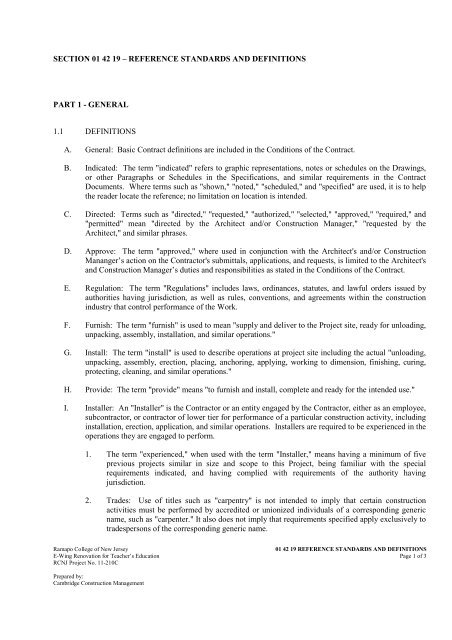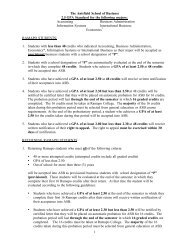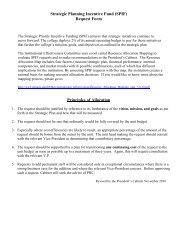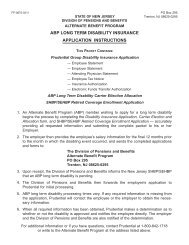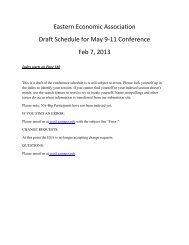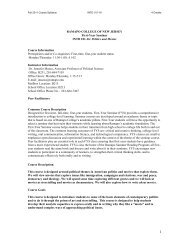Project Manual 11-210C - Ramapo College of New Jersey
Project Manual 11-210C - Ramapo College of New Jersey
Project Manual 11-210C - Ramapo College of New Jersey
You also want an ePaper? Increase the reach of your titles
YUMPU automatically turns print PDFs into web optimized ePapers that Google loves.
SECTION 01 42 19 – REFERENCE STANDARDS AND DEFINITIONS<br />
PART 1 - GENERAL<br />
1.1 DEFINITIONS<br />
A. General: Basic Contract definitions are included in the Conditions <strong>of</strong> the Contract.<br />
B. Indicated: The term "indicated" refers to graphic representations, notes or schedules on the Drawings,<br />
or other Paragraphs or Schedules in the Specifications, and similar requirements in the Contract<br />
Documents. Where terms such as "shown," "noted," "scheduled," and "specified" are used, it is to help<br />
the reader locate the reference; no limitation on location is intended.<br />
C. Directed: Terms such as "directed," "requested," "authorized," "selected," "approved," "required," and<br />
"permitted" mean "directed by the Architect and/or Construction Manager," "requested by the<br />
Architect," and similar phrases.<br />
D. Approve: The term "approved," where used in conjunction with the Architect's and/or Construction<br />
Mananger’s action on the Contractor's submittals, applications, and requests, is limited to the Architect's<br />
and Construction Manager’s duties and responsibilities as stated in the Conditions <strong>of</strong> the Contract.<br />
E. Regulation: The term "Regulations" includes laws, ordinances, statutes, and lawful orders issued by<br />
authorities having jurisdiction, as well as rules, conventions, and agreements within the construction<br />
industry that control performance <strong>of</strong> the Work.<br />
F. Furnish: The term "furnish" is used to mean "supply and deliver to the <strong>Project</strong> site, ready for unloading,<br />
unpacking, assembly, installation, and similar operations."<br />
G. Install: The term "install" is used to describe operations at project site including the actual "unloading,<br />
unpacking, assembly, erection, placing, anchoring, applying, working to dimension, finishing, curing,<br />
protecting, cleaning, and similar operations."<br />
H. Provide: The term "provide" means "to furnish and install, complete and ready for the intended use."<br />
I. Installer: An "Installer" is the Contractor or an entity engaged by the Contractor, either as an employee,<br />
subcontractor, or contractor <strong>of</strong> lower tier for performance <strong>of</strong> a particular construction activity, including<br />
installation, erection, application, and similar operations. Installers are required to be experienced in the<br />
operations they are engaged to perform.<br />
1. The term "experienced," when used with the term "Installer," means having a minimum <strong>of</strong> five<br />
previous projects similar in size and scope to this <strong>Project</strong>, being familiar with the special<br />
requirements indicated, and having complied with requirements <strong>of</strong> the authority having<br />
jurisdiction.<br />
2. Trades: Use <strong>of</strong> titles such as "carpentry" is not intended to imply that certain construction<br />
activities must be performed by accredited or unionized individuals <strong>of</strong> a corresponding generic<br />
name, such as "carpenter." It also does not imply that requirements specified apply exclusively to<br />
tradespersons <strong>of</strong> the corresponding generic name.<br />
<strong>Ramapo</strong> <strong>College</strong> <strong>of</strong> <strong>New</strong> <strong>Jersey</strong><br />
01 42 19 REFERENCE STANDARDS AND DEFINITIONS<br />
E-Wing Renovation for Teacher’s Education Page 1 <strong>of</strong> 3<br />
RCNJ <strong>Project</strong> No. <strong>11</strong>-<strong>210C</strong><br />
Prepared by:<br />
Cambridge Construction Management


